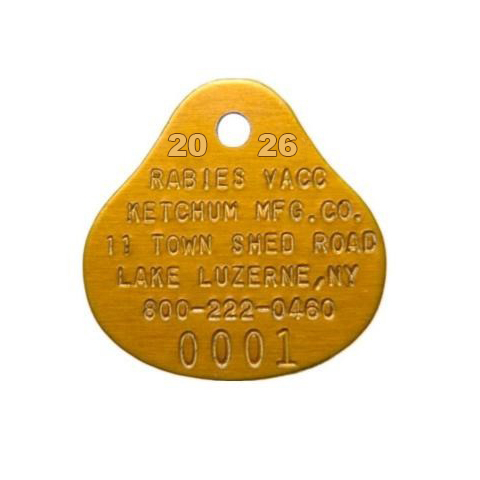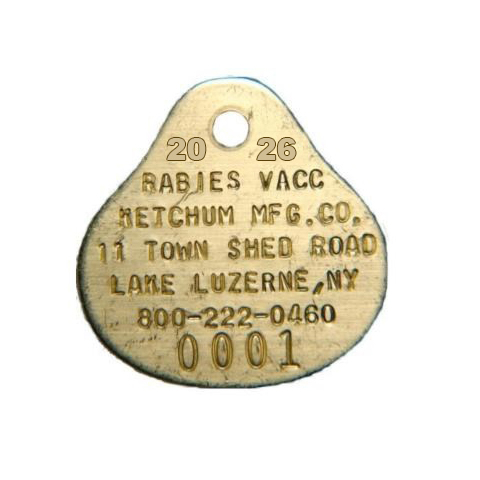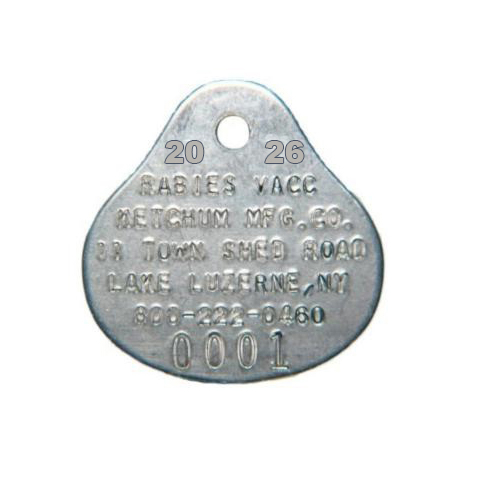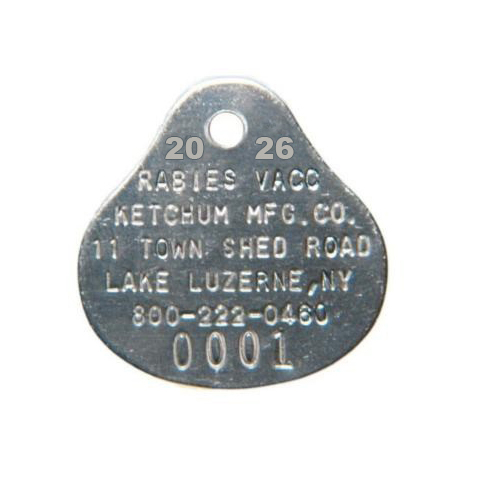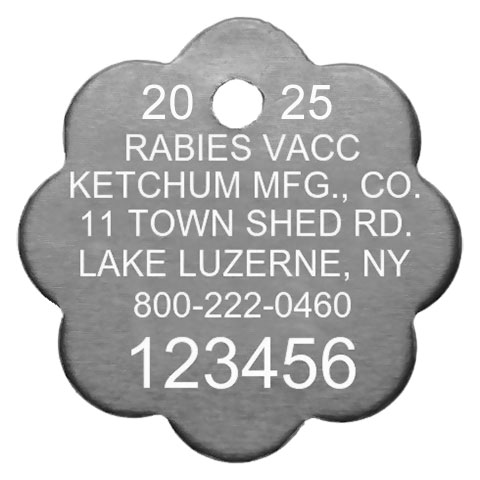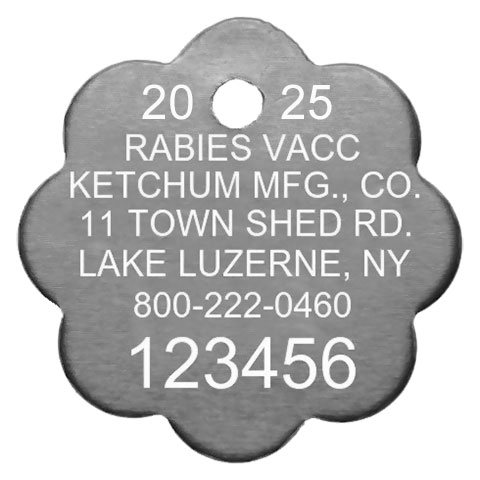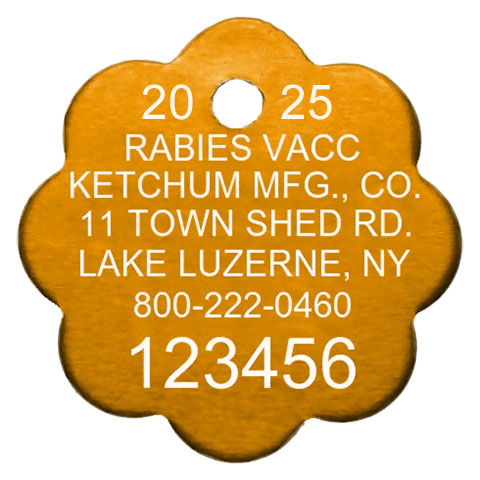2026 Rabies Tags
Every dog and cat needs rabies vaccination tags in addition to their regular pet identification tags, and you can find exactly what you're looking for right here at Ketchum Manufacturing.
Locally produced and manufactured in upstate New York, our rabies tags are built from the highest quality aluminum, brass or steel for lasting durability.
200 piece minimum order.
2025 Rabies Tags
2025 tags are still in production — but not for long! If you're running low, now’s the time to place your final orders before production shifts fully to 2026.
Why Keeping Pet Rabies Tags Current Really Matters
When it comes to rabies tags and the well-being of their dog or cat, pet owners often wonder...
- How a rabies tag protects their pet; and
- Why the tag’s shape and color change every year.
Your Pet’s Health
The answer to the first question is easy: the tag itself doesn’t protect their pet from rabies at all—at least not directly. Rather, every up-to-date rabies tag is imprinted with a number unique to the animal, along with contact information for the veterinary clinic that administered the rabies vaccine. It is the vaccine itself, of course, that provides immunity against the rabies virus in the event the dog or cat is bitten by or otherwise exposed to the saliva of an infected animal. The tag simply documents that the pet has been inoculated against the disease.
Your Pet’s Rabies Tag
The answer to the second question has some history behind it. While individual owners may opt for a custom or “vanity” shape and/or color for their pet’s rabies tag, it is important that they understand the significance and purpose of a given year’s rabies tag design. Currently, as recommended by the National Association of Public Health Veterinarians (NASPHV), the internationally recognized standard by the most recent years is as follows:
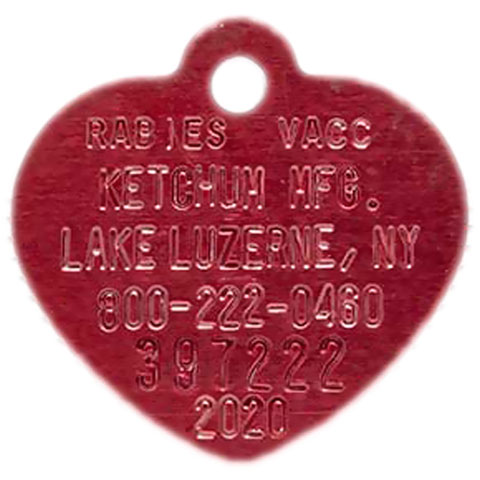
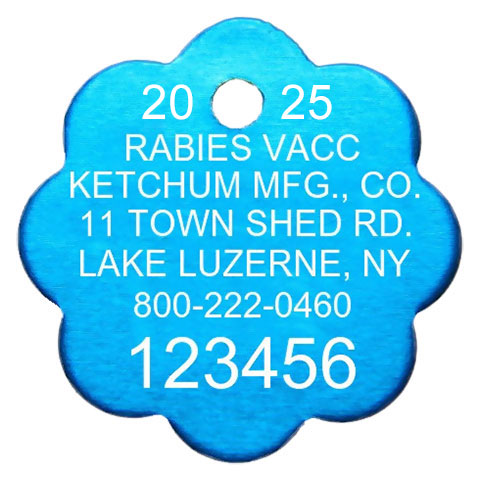
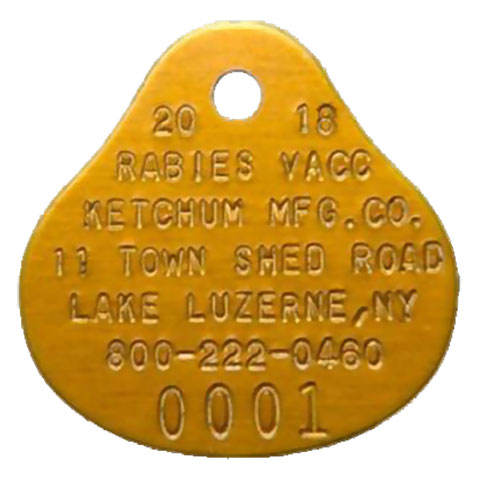
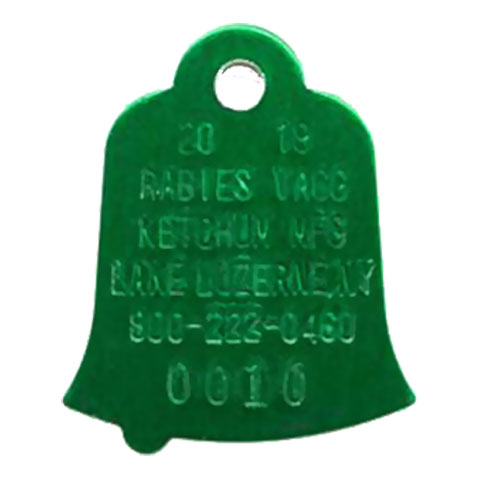
As should be obvious, this system of shapes and colors does a full rotation every four years. Why does this matter? For one thing, at a glance it serves to remind pet owners and their vets to keep the animal’s inoculations up to date.
More importantly, it helps local public health authorities and animal control officers to determine—from a distance—whether someone’s stray pet has had their current rabies vaccine administered. For the latter reason, it is vitally important that you do not allow your pet to “collect” past years’ rabies tags on their collar, as if the tags are some kind of honor badge array or jingly jewelry. Any misperception or confusion in this regard puts your pet at risk! No pet owner would be happy to learn their beloved animal was euthanized because it was acting suspiciously—and wearing the wrong tag.
Therefore, every time your dog or cat is inoculated against rabies, remove the old tag from its collar and replace it with the new, current year’s rabies tag issued to you by your vet.
It’s Not a Fashion Statement—It’s Life or Death
If your dog or cat is strictly an indoor animal and never leaves the home, it may not matter which shape or color you choose for your pet’s rabies tag. What does matter is that you get them inoculated regularly according to your state and local jurisdiction’s regulations and recommended dosing schedule. Why? Because vaccination is safe—and it works!
One recent disturbing trend is that some pet owners, inspired by the human anti-vax movement, now refuse to get their animals inoculated at all. Adherents to this pet anti-vax movement are grievously misinformed; and their actions can have grave consequences for all, humans and animals alike.
Consider this: until Louis Pasteur developed an effective vaccine in 1885, the rabies infection had a 100% mortality rate. Immediately after his discovery, the number of deaths from rabies in Europe and the Americas plummeted. Nevertheless, about 60,000 people worldwide still die each year because of rabies (mostly in underdeveloped nations in Africa and Asia). Yet, in the United States, the fatality rate is just 1 or 2 per year—thanks largely to the efforts of federal, state, and local authorities in encouraging cat and dog owners to vaccinate their pets.
To learn more about the importance of rabies tags and what you can do to help wipe this disease off the face of the Earth, please see our FAQs or visit the CDC Rabies.
As this video shows, whether you are a vaccinator in a country where dog rabies is still a problem or a pet owner here in the U.S., we all have a crucial role to play in preventing this deadly disease. Vaccinate your dogs and cats!
Rabies FAQs
-
Rabies is a deadly disease caused by a virus that attacks the central nervous system (brain and spinal cord). Infected mammals can transmit rabies virus to humans and other mammals. Rabies is almost always fatal once symptoms appear. Fortunately, only a few human cases are reported each year in the United States.
-
Rabies is most often seen among wild animals such as raccoons, bats, skunks and foxes, but any mammal can be infected with rabies. Pets and livestock can get rabies if they are not vaccinated to protect them against infection. Among domestic animals, cats are most frequently diagnosed with rabies in New York State.
Some animals almost never get rabies. These include rabbits and small rodents such as squirrels, chipmunks, rats, mice, guinea pigs, gerbils and hamsters. It is possible for these animals to get rabies, but only in rare circumstances, such as if they are attacked but not killed by a rabid animal.
Reptiles (such as lizards and snakes), amphibians (like frogs), birds, fish and insects do not get or carry rabies.
-
The first sign of rabies is usually a change in an animal's behavior. It may become unusually aggressive or tame. The animal may lose its fear of people and natural enemies. A wild animal may appear affectionate and friendly. It may become excited or irritable and attack anything in its path. Staggering, convulsions, choking, frothing at the mouth and paralysis are sometimes seen. Many animals will make very unusual sounds. Infected animals usually die within one week after showing signs of rabies.
-
People usually get exposed to the rabies virus when an infected animal bites them. Exposure may also occur if saliva from a rabid animal enters an open cut or mucous membrane (eyes, nose or mouth).
-
Wash all wounds thoroughly with soap and water and seek medical attention immediately. Report all animal bites to your county health department, even if they seem minor. The phone number for your county health department can be found in the government listing of your telephone directory or the New York State Department of Health (NYSDOH) website.
Try to keep track of the animal that exposed you and report this information to your county health department so the animal can be captured safely, if possible. In the case of a bat, you may be able to safely capture it yourself and take it to your county health department where it will be transferred to the state for rabies testing.
Healthy dogs, cats, ferrets and livestock that have bitten or otherwise caused a potential human exposure to rabies will be confined under the direction of the county health department and observed for ten days following the exposure. If the animal remains healthy during this period, the animal did not transmit rabies at the time of the bite.
Other types of animals that cause a potential human exposure must be tested for rabies under the direction of the county health department. If an animal cannot be observed or tested for rabies, treatment may be necessary for the people exposed. Your county health department will assist you and your physician to determine whether treatment is necessary.
-
Treatment after rabies exposure consists of a dose of human rabies immune globulin (HRIG) administered as soon as possible after exposure, plus 4 doses of rabies vaccine given over two weeks. If there is a wound, the full dose of HRIG should go into the wound, if possible. The first vaccine dose is given at the same time, with the remaining injections given on days 3, 7 and 14 following the initial injection. People who have weakened immune systems may require a fifth dose of vaccine, as determined by their doctor.
A person who has already been vaccinated for rabies and is exposed to rabies must receive two booster vaccine doses three days apart immediately after exposure. They do not need an injection of HRIG.
-
Exposure to a rabid animal does not always result in rabies. If treatment is initiated promptly following a rabies exposure, rabies can be prevented. If a rabies exposure is not treated and a person develops clinical signs of rabies, the disease almost always results in death.
-
The best way to keep pets safe from rabies is to vaccinate them and keep their shots up-to-date. If your pet has been injured by a rabid animal, contact your veterinarian to get medical care. Even though your pet has been vaccinated, a booster dose of rabies vaccine may be needed within five days of the incident. Contact your county health department to determine what additional follow-up may be needed.
-
- Don't feed, touch or adopt wild animals, stray dogs or cats.
- Be sure your pet dogs, cats and ferrets as well as horses and valuable livestock animals are up-to-date on their rabies vaccinations. Vaccination protects pets if they are exposed to rabid animals. Pets too young to be vaccinated should be kept indoors and allowed outside only under direct observation.
- Keep family pets indoors at night. Don't leave them outside unattended or let them roam free.
- Don't attract wild animals to your home or yard. Keep your property free of stored bird seed or other foods that may attract wild animals. Feed pets indoors. Tightly cap or put away garbage cans. Board up any openings to your attic, basement, porch or garage. Cap your chimney with screens.
- If nuisance wild animals are living in parts of your home, consult with a nuisance wildlife control expert about having them removed. You can find wildlife control experts, who work on a fee-for-service basis, in your telephone directory under pest control.
- Teach children not to touch any animal they do not know and to tell an adult immediately if they are bitten by any animal.
- If a wild animal is on your property, let it wander away. Bring children and pets indoors and alert neighbors who are outside. You may contact a nuisance wildlife control expert who will remove the animal for a fee.
- Report all animal bites or contact with wild animals to your county health department. If possible, do not let any animal escape that has possibly exposed someone to rabies.
-
The county health department is your best source of additional rabies information. The phone number for your county health department can be found in the government listing of your telephone directory or the NYSDOH website.
Detailed rabies information is also available at the following websites:
NYSDOH: Rabies
Centers for Disease Control and Prevention (CDC): Rabies
Note: all of the information above is the property of the New York State Department of Health.

